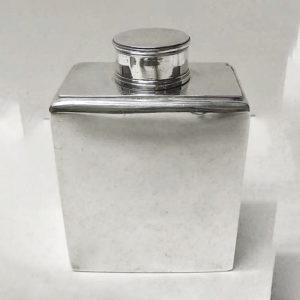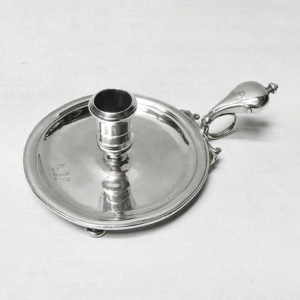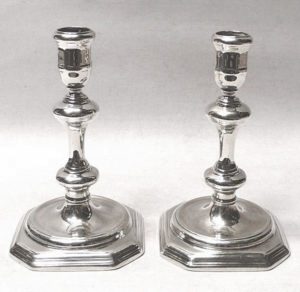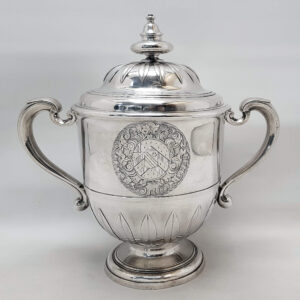Simon Pantin
Simon Pantin (1666-1733) came from a long line of Rouen goldsmiths dating back to the late 16th century when Jacob Pantin, Simon’s great-great grandfather first entered the distinctive peacock maker’s mark which continued to be used by successive generations of the Pantin family.
Simon came to England in the early 1680’s as a refugee when his family fled the Huguenot persecution in France. The Pantins settled within the Rouen protestant community in London where they already had existing family members. Simon’s father had been a practising goldsmith in France and his son Simon was apprenticed to the prestigious Pierre Harache, also from Rouen, in 1686. Freed from his apprenticeship in 1693, aged 27, Simon finally obtained his freedom of the Goldsmith’s Company in 1701 and entered his first mark (Britannia Standard) 3 weeks later giving an address in St Martins Lane. Simon subsequently moved nearby to Castle St at “the sign of the peacock” in 1706 where he remained until his death in 1733. 2nd mark 1717, 3rd mark (Sterling) 1720. All marks incorporated the Pantin trademark “peacock”. Livery, October 1712.
Simon married (date unknown) Marthe de Joncourt, a Huguenot refugee from Saint-Quentin in France and they had at least 7 children of whom 3 died young and 3 became goldsmiths – Elizabeth (Eliza Godfrey), Simon II and Lewis Pantin.
Simon took 9 apprentices, all Huguenot, including Augustin Courtauld, Peter Courtauld, Abraham Buteux (his nephew and godson) and Simon Pantin II (his son).
Simon Pantin’s extensive work includes many fine specimens on display in museums and institutions worldwide including the beautiful tureen in the Hermitage Museum, St Petersburg and the 1724 “Bowes” tea set in the Metropolitan Museum, New York. His expert technique, elegant style and minimal use of decoration was ideally suited to his main output of domestic teawares (tea canisters, teapots and kettles) and expertly cast candlesticks.
biography extracted from Sandra Robinson’s “Simon Pantin & His Children”
Simon Pantin
Simon Pantin (1666-1733) came from a long line of Rouen goldsmiths dating back to the late 16th century when Jacob Pantin, Simon’s great-great grandfather first entered the distinctive peacock maker’s mark which continued to be used by successive generations of the Pantin family.
Simon came to England in the early 1680’s as a refugee when his family fled the Huguenot persecution in France. The Pantins settled within the Rouen protestant community in London where they already had existing family members. Simon’s father had been a practising goldsmith in France and his son Simon was apprenticed to the prestigious Pierre Harache, also from Rouen, in 1686. Freed from his apprenticeship in 1693, aged 27, Simon finally obtained his freedom of the Goldsmith’s Company in 1701 and entered his first mark (Britannia Standard) 3 weeks later giving an address in St Martins Lane. Simon subsequently moved nearby to Castle St at “the sign of the peacock” in 1706 where he remained until his death in 1733. 2nd mark 1717, 3rd mark (Sterling) 1720. All marks incorporated the Pantin trademark “peacock”. Livery, October 1712.
Simon married (date unknown) Marthe de Joncourt, a Huguenot refugee from Saint-Quentin in France and they had at least 7 children of whom 3 died young and 3 became goldsmiths – Elizabeth (Eliza Godfrey), Simon II and Lewis Pantin.
Simon took 9 apprentices, all Huguenot, including Augustin Courtauld, Peter Courtauld, Abraham Buteux (his nephew and godson) and Simon Pantin II (his son).
Simon Pantin’s extensive work includes many fine specimens on display in museums and institutions worldwide including the beautiful tureen in the Hermitage Museum, St Petersburg and the 1724 “Bowes” tea set in the Metropolitan Museum, New York. His expert technique, elegant style and minimal use of decoration was ideally suited to his main output of domestic teawares (tea canisters, teapots and kettles) and expertly cast candlesticks.
biography extracted from Sandra Robinson’s “Simon Pantin & His Children”
-


1702
Simon Pantin
3557 Queen Anne Silver Tea Caddies
Sold
A rare pair of antique Britannia standard* silver tea containers of heavy rectangular design and having engraved armorials and lift off lids. Weight 21 troy ounces. Height 12 cms. Width 8.5 cms. Depth 5 cms. London 1702. By Simon Pantin.
-


1704
Simon Pantin
7725 Queen Anne Silver Chamberstick
Sold
A rare early English silver chamber stick (also known as a go to bed) with the solid design and excellent heavy gauge silver as you’d expect from this date. It has the early form with a flat teardrop handle and broad drip pan. The circular base is hand engraved with the crest of a crowned lion’s head erased between two plumes, all mounted on three small stump feet. Weight 225 grams, 7.25 troy ounces. Diameter 11.5 cms, 4.5 inches. Length 17 cms. Britannia standard silver*. London 1704. By Simon Pantin.
-


1709
Simon Pantin
7762 Queen Anne Silver Candlesticks by Simon Pantin
Sold
A beautiful pair of rare early English silver candlesticks. Britannia standard silver*. Lovely plain style in keeping with the period. Very solid and heavy cast metal with knopped and baluster vase shaped stems and square hollowed out bases with canted corners. Traces of a crest. Excellent colour. Weight 795 grams, 25.5 troy ounces. Height 16.5cm. Base 10cm square. London 1709. Maker Simon Pantin.
-


1711
Simon Pantin
10350 Queen Anne Antique Silver Cup and Cover
Sold
A magnificent antique silver cup and cover of campana form with twin side handles. Lovely plain style, very good weight and large size. Excellent quality with the cut card banding typical of this sought after Huguenot maker. Engraved to the front is a large marital coat of arms for Bagot and Wagstaffe contained within a contemporary cartouche; the lid has a goat crest. Total weight 2976g, 95.6 troy oz. Height 32.5cm (to top of lid), 22.2cm (to top of cup rim). Spread across handles 33cm. Diameter of top 19.5cm. London 1711. Maker Simon Pantin. Britannia standard silver.